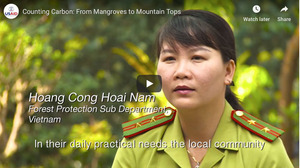Mangroves deliver research surprise 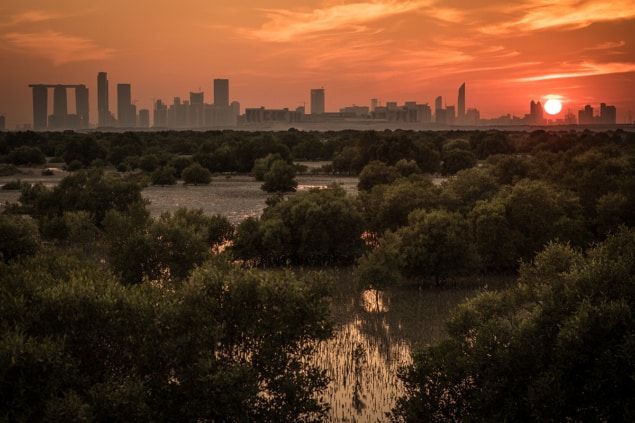
GLOBAL – Rates of growth and loss in mangrove forests are higher than previous estimates, according to satellite measurements of the Rufiji, Zambezi, Ganges and Mekong deltas. And natural expansion and growth of new mangrove forests could partially compensate for declines caused by human activity. “What we see for these types of mangrove delta regions is that there is rapid expansion and growth — in about 20 years, forest canopies can reach a mature height of over 20 m,” says David Lagomasino from the University of Maryland and the NASA Goddard Space Flight Center, both in the US. “In some places that fast growth can help to offset the losses, both in terms of extent of the forests and carbon density.” Mangrove forests make up a relatively minor part of the Earth’s total forested area, but their importance exceeds the scale of their footprint. They sequester proportionally more carbon than almost any other ecosystem — their maximum storage potential above and below ground is more than 1000 tonnes per hectare – and they provide food, shelter, fuel and coastal protection. Mangrove extent is decreasing due to urbanization and expanding agriculture and aquaculture but natural coastal processes like erosion and deposition also play a role.
READ MORE AFRICA
Major new inquiry into oil spills in Nigeria's Niger Delta launched
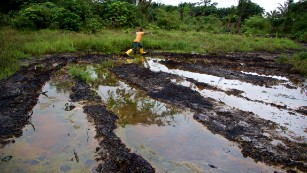
NIGERIA – The Niger Delta is a diverse region with rich mangroves and fish-rich waterways. Many residents try to make their livelihoods from fishing and farming. A major new inquiry into oil companies operating in the Niger Delta has been launched by the Archbishop of York, John Sentamu. The probe will investigate "environmental and human damage" in Nigeria's vast oil fields. "This Commission will investigate the human and environmental impact of multinational oil company activity and is crucial to the prosperous future of the people of Bayelsa and their environment, Nigeria and hopefully to other oil-producing nations," he said. Nigeria is Africa's largest oil producer. The country's crude oil production — estimated at over 300 million liters per day — makes up 70 percent of the Nigerian government's revenue. This new commission, convened by Bayelsa Governor Seriake Dickson, says that it wants to make oil companies in the region more accountable. "The world has looked on for too long without taking the necessary collective action to put a stop to the damage being done by oil companies in Bayelsa. We must put the environment and the health and wellbeing of our communities first," Dickson said in a statement. READ MORE
Insecurity hindering Ogoni Clean-up

NIGERIA – A senator, Magnus Abe (APC, Rivers), has blamed the slow pace of the proposed clean-up exercise in the oil-rich Ogoni land in Rivers State on insecurity. He said no meaningful clean-up exercise could take place in Ogoni land at the moment due to serious security challenges in the area. Ogoni area in Rivers State has over the years been destroyed by oil spills leading to the destruction of surrounding waters and farm lands. A report by the United Nations Environment Programme (UNEP) recommended the total clean up of the environment saying the extent of water and environmental pollution in the Rivers communities was alarming. The senator also said any clean up that goes on without first addressing the issue of the continued pollution of the environment “is a waste of everybody’s money because as the clean up is going on, the criminals will be spoiling the exercise.” READ MORE
ASIA
Can Mangroves Mitigate Catastrophic Consequences Of Cyclone-Induced Storm Surges?

BANGLADESH – Susmita Dasgupta a Lead Environmental Economist in the Environment and Energy Team of the Development Research Group recently conducted research in collaboration with the Institute of Water Modeling in Bangladesh on the consequences of cyclone-Induced storm surges. Massive flooding from storm surges is a major threat to lives and property in low-lying coastal areas during cyclones. The impacts are particularly disastrous when storm surges strike densely populated coastal areas without storm-resilient infrastructure, as the recent storm Idai (March 2019) brutally demonstrated. This category 3 cyclone caused widespread damages and loss of life in Mozambique, Zimbabwe, Malawi, and Madagascar, killing 432 people and severely affecting more than 2.5 million of the population. The study focused on seven coastal locations. The study showed varying levels of protection from mangroves for different tree species and forest widths and densities across the seven locations. Sonneratia apetala was the species that provided the greatest protection. Mangroves generally reduced surge height by 4cm to 16.5cm with mangrove belts of 50m to 2km width, and reduced water flow velocity by 29 to 92 percent with forest widths of 50m or 100m. The findings also highlighted that the range of protection is location-specific. Quantifying the protective capacity of mangroves from storm surges in coastal Bangladesh, their study emphasizes the important role mangroves can play in a multi-dimensional approach for protection against cyclonic surges. . READ MORE
Farmers irked over 1.5 Lakh of mangroves spread across 19 hectares to be cleared

INDIA – Farmers of Palghar and Dahanu districts of Maharashtra have expressed disappointment at the ministry of environment, forests and climate change (MoEF) giving clearance to the National High Speed Railway Corporation Limited (NHSRCL) to remove 1.5 lakh mangrove trees. They said that they will not let the bullet train body carry out the survey for land acquisition in Palghar. Moreover, the farmers’ and villagers’ group from Palghar Bhumi Putra Bachao Andolan, has fielded its own candidate for the upcoming Lok Sabha elections as an independent candidate. Earlier, the NHSRCL told the Bombay high court that it had received permission from the Union environment ministry to hack 1.5 lakh mangroves from Thane, Palghar and Navi Mumbai districts. “The environment ministry seems to be in a hurry to grant permissions for hacking mangroves, even when a case regarding the bullet train is being heard in the Gujarat court. We have fielded one candidate from our group who will be representing issues like irregular environment destruction and land acquisition in Mumbai and surrounding areas,” said Sameer Vartak, a member of the Bhumi Bachao Andolan. “We are against land acquisition and the cutting of mangroves in Palghar for the bullet train project, along with other cases of damage to the environment in projects such as the Metro 3, READ MORE
Sri Lankan Navy seizes 8 for cutting mangrove shrubs
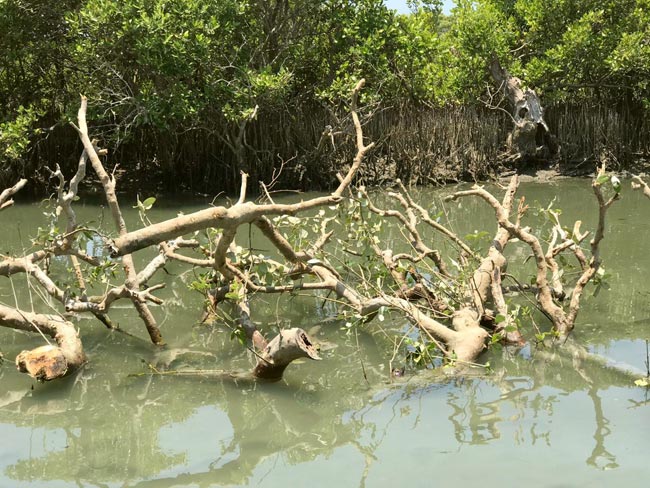
SRI-LANKA – A group of Naval personnel attached to the North Central Naval Command together with officials of Wildlife Conservation Department-Mannar attached to the Madu office, nabbed 8 persons who were cutting mangrove shrubs, during a raid carried out in Udeiadi lagoon area, Wankalai, yesterday(09). The Sri Lanka Navy stated that a few mangrove branches cut by the suspects, two knives and 2 axes used for cutting mangrove were taken into naval custody. The suspects are residents of Mannar area in the ages of 43, 38, 31, 29, 27 and 19. Officers of the Wildlife Conservation Department conducts further investigation on arrested suspects and mangrove poles. This mangrove ecosystem which is an authentic resource activate against the soil erosion is destroyed only by very few people and SL Navy keeps a watchful eye on such groups to foil their attempts and to enforce the law against them. Further, the Navy has launched several projects successfully to replant the mangrove around the lagoon areas of the island. Especially, at present, these mangrove replanting projects are being actively maintained in Northern, North Central, North Western, and Southeastern Naval areas. The main objective of these projects is to conserve and protect the coastal belt around Sri Lanka.
Environmentalists accuse salt firm of brazenly illegally destroying forest, people's livelihoods
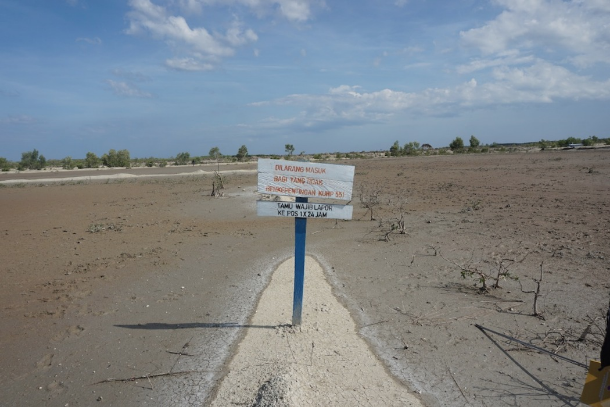
INDONESIA – A coalition of church and environment advocacy groups have called for action to be taken against a salt company they accuse of illegally destroying more than 240 hectares of mangrove forest in Indonesia’s East Nusa Tenggara province. The Franciscan commission for Justice, Peace and Integrity of Creation (JPIC) and the Indonesian Forum for the Environment (WALHI) filed a complaint on March 27 with police in Kupang, the provincial capital, against PT Daya Inti Kencana. They said the firm was operating without a license and violating laws regulating coastal area and forestry management that protect mangrove forests. The company's activities had resulted in the illegal eviction of indigenous peoples and the clearing of 242 hectares of mangrove in Malaka district to facilitate its salt production, according to the activists. This area was important source of income for the indigenous people living in the area, the coalition said. If found acting illegally those responsible could face 10 years in prison and a US$700,000 fine. Father Alsis Goa Wonga, director of the JPIC, said every development project should be oriented to improve the welfare of communities, and should not neglect ecological, cultural and social conditions, as well as existing laws. "What is happening in Malaka is a result of ignoring all this," he told ucanews.com. READ MORE
Police arrest two for cutting mangrove trees

PAKISTAN – Police claimed to have arrested two members of a gang involved in the illegal cutting of mangrove trees in Karachi on Sunday. Carrying out action against loggers, police arrested two who were allegedly belonging to a gang involved in timber smuggling. The arrests were made in Ibrahim Hyderi area of the metropolis. Law enforcers have also recovered more than 200 tons of mangrove tree wood loaded on a truck during the raid. According to Senior Superintendent Police (SSP) Malir, the accused persons, Kamran and Mazhar, were arrested from Chashma roundabout. He said that the persons were involved in the illegal cutting of tree and selling of the wood into timber market. A case was registered against the accused persons under the Forest Act, he added. Earlier in October last year, the officials of Forest Department in Chitral had foiled a bid to smuggle two truckloads of timber and arrested two persons. READ MORE
Commodification of Living Space for Coastal Communities

INDONESIA – As a maritime country, Indonesia has an abundance of marine and fisheries resources that can be found in coastal areas, small islands and deep water region. Not only the potential of capture fisheries, Indonesia also has abundant coastal and other marine resources, including the area of 2.6 million hectares of mangrove forest; tropical forest area on small islands of 4.1 million hectares, area of 1,110,900 hectares of seaweed cultivation, and salt ponds covering more than 25 thousand hectares. All of these resources should have a positive impact on the lives of coastal communities in Indonesia (traditional fisherfolks, fisherwomen, aquaculture, salt farmers, preservers of coastal ecosystems, and coastal indigenous communities) both economically and socially. Not only that, with this wealth of marine and fishery resources, coastal communities should be the main actors in development. However, to this day, we find the fact that more than 7.87 million people or 25.14 percent of the total national poor population are those who depend his live on the marine sector. In other words, those who have been living in coastal areas and small islands are the poor people. Then, where is the root of the problem? The answer is that the arrangement of space in coastal areas and small islands that doesn’t provide a fair space for coastal communities. READ MORE
AMERICAS
Seawalls and the tyranny of small decisions
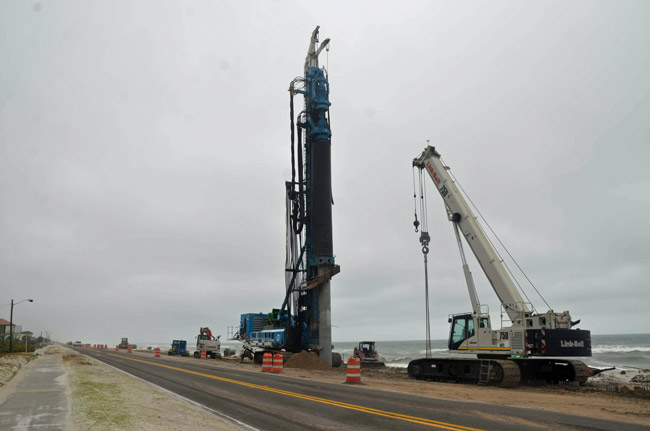
USA – “They start at 6 a.m., if you can believe it,” my friend told me with a hint of frustration. This was his neighborhood, and we were both gawking at a huge pile-driver sitting atop the dune across from the Turtle Shack in Flagler Beach. The machine is being used to sink pillars 30 feet down as foundation for the new concrete seawall being constructed by the Florida Department of Transportation. I hadn’t visited Flagler Beach in more than a year, and sitting there with my friend, looking at the scale of the construction underway, it was clear that the city and its beaches will never be the same again. These seawalls are being installed along both North and South A1A in the name of protecting local businesses and property. But will they? Most people would agree that being business-friendly in Flagler Beach also means acknowledging that local shops and restaurants are unlikely to thrive if the local beach disappears. And with sea level rise and stronger hurricanes as a result of climate change, the destruction and loss of beaches not only in Flagler, but around Florida, is already becoming a stark reality. A shocking study conducted by researchers at University of North Carolina Chapel Hill, reported in the prestigious journal Science, used data from NOAA to show that nearly 15 percent of the entire United States’ shoreline is covered in concrete. READ MORE
EUROPE
An easy, cost-effective way to address climate change? Massive reforestation.

UK – As the implications of climate change become starker and the world faces up to a biodiversity crisis that threatens humanity’s existence, a group of campaigners from across the world are saying there is one clear way to get us out of this mess, but that governments are ignoring it In an open letter published in the British newspaper, The Guardian, the group tells governments that the best and cheapest way to avert a climate catastrophe is to heal nature by restoring and replanting degraded forests and by better conserving the natural world. “Defending the living world and defending the climate are, in many cases, one and the same. This potential has so far been largely overlooked,” say the 23 signatories to the letter. “We call on governments to support natural climate solutions with an urgent program of research, funding, and political commitment,” they added. Vast amounts of carbon can be removed from the air and stored by restoring ecosystems razed by palm oil plantations, cattle ranching and timber, and fish production, the letter says. The 23 signatories include the teenage school climate strike activist Greta Thunburg, authors Margaret Atwood, Naomi Klein, and Philip Pullman, U.S. climate scientist Michael Mann, and environmental campaigner Bill McKibben. “The world faces two existential crises, developing with terrifying speed: climate breakdown and ecological breakdown. Neither is being addressed with the urgency needed to prevent our life-support systems from spiralling into collapse,” say the signatories. READ MORE
OCEANA
The Great Barrier Reef's Secret Climate Change Weapon Is This Switzerland-Sized Meadow of Seagrass

AUSTRALIA – Tourists frequently flock to Lizard Island, off the northeastern coast of Australia, to marvel the Great Barrier Reef. Among the dugongs, sea turtles, and jewel-toned corals, though, there’s another organism that doesn’t get nearly as much credit as it deserves: seagrass. a team of Australian scientists has discovered that seagrasses of the Great Barrier Reef are absorbing climate-warming carbon dioxide from the atmosphere at a surprisingly high rate rate. This reef-bound carbon sink is one of many so-called “Blue Carbon” sinks. These are aquatic and marine environments which effectively store carbon, helping to mitigate climate change. Other such carbon sinks include marshes and mangrove forests. Beds of the seagrass Halophila draw down about the same amount of carbon at depth as they do in shallower regions—a result the team was not expecting, per the study. Deepwater seagrass habitats held about nine times the amount of organic carbon as the bare sediment around them. Extrapolating their measurements to the entire estimated deep-water Halophila habitat, they arrived at roughly 30 million tons of stored carbon. READ MORE
Back to Top
















